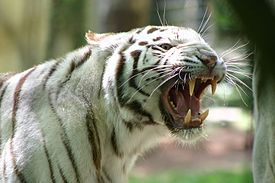Carnivorous
A carnivore (from the Latin carnivŏrus, 'flesh eater'), is an organism that obtains its energy and nutritional requirements through a diet consisting mainly of or exclusively in the consumption of meat, either through predation or the consumption of carrion. The preferred term in ecology is zoophagous.
There are more specific adjectives to refer to animals that feed on specific classes of prey, as is the case of animals that eat insects, called insectivores or also entomophages, and within these one can still distinguish, for example, a the ant and termite eaters, calling them myrmecophages. Carnivores are always found in advanced positions in the food chain.
Classification
Although there are many species of animals that are considered exclusively carnivorous, some subspecies are not exclusive meat eaters. For example, most bear species are omnivorous, the exception being the giant panda, whose diet consists almost entirely of bamboo consumption.
Apart from the animal world, there are a large number of carnivorous plants and even carnivorous fungi. The former are predominantly insectivorous, while the latter subsist by consuming microscopic invertebrates, such as amoebas and springtails.
Strict Carnivores
A true or strict carnivore is one that subsists on a diet of meat only, its ability to use other resources being marginal. Although they can consume small amounts of plant matter, they do not have a physiology suitable for efficient digestion.
Features
Carnivores have a series of characteristics in common, such as organs for capturing and disarticulating prey (teeth and claws fulfill this function in many vertebrates). Despite this, many carnivores do not hunt and indulge in carrion consumption (however many hunters will consume carrion when the opportunity exists). Carnivores have a comparatively shorter digestive system because they do not require breaking down the cellulose found in plants.
Prehistoric Carnivores
Some theropod dinosaurs that existed during the Cretaceous, such as Tyrannosaurus rex, were carnivorous.
Prehistoric mammals of the crown group Carnivoramorpha (Carnivora and Miacoidea without Creodonta), along with the early order Creodonta, and some mammals of the similarly early order Cimolesta, were true carnivores. The first carnivorous mammals are considered to be the Cimolestes that existed during the Late Cretaceous and Tertiary periods of North America 65 million years ago. Most Cimolestes species were the size of a mouse or rat, but by the late Cretaceous Cimolestes magnus reached the size of a marmot, making it one of the largest known Mesozoic mammals (20-60g). Their molars combined the functions of drilling, cutting, and grinding, and the molars of Palaeoryctes had very high, sharp cusps that had very little function outside of drilling. In the Cimolestes dentition they prefigure the same cutting structures seen in all later carnivores. While the smaller species were insectivorous, Cimolestes magnus probably took larger prey and were certainly carnivorous to some degree. The molars of the Hyracolestes ermineus ("shrew-like stoats" weighing 40 g) and Sarcodon pygmaeus ("pygmy carnivorous teeth" weighing 75 g), were common in the last Paleocene stage of Mongolia and China, and took the place of small predators. Their molars show the same characteristic notches that serve in today's carnivores to hold meat in place to cut off pieces with sharp edges.
Examples of some carnivores
- Mammals.
- All the felines, like the domestic cat, big felidos and mangostas among others.
- Some canids, like the grey wolf. The coyote and the red wolf are not strict carnivores. The domestic dog is considered a strict carnivore, but this situation is discussed.
- Hienidos (less the Cristata Proteles that is omnivorous).
- Some mustards, like the ferret.
- The polar bear (the other bears are eggheads).
- All cetaceans, like whales and dolphins.
- Some bats.
- The members of the Viverridae family, such as gin and binturong.
- Reptiles.
- All Crocodylidae family, like crocodiles and caimans.
- All snakes, like cobras, piths and boas.
- Some turtles, including sea turtles.
- Fish and amphibians.
- Sapos, frogs and salamanders in their adult phase.
- All sharks.
- Bone fish, like tuna and salmon.
- Birds.
- Birds of daytime prey (aguilas, milanos, etc.) and nighttime (buho lettuce, etc.).
- Several seabirds, like pelicans and penguins.
- All vultures, both those of the New World and those of the Old World.
- Invertebrates.
- Some crustaceans.
- Moluccas such as octopuses, squids and some gastropods.
- Spiders and scorpions.
- Some insects, such as religious mantis and wasps.
There are also some species of plants called carnivorous plants: they supplement their nutrient input with small insects, nematodes, and other small invertebrates.
Contenido relacionado
Euglenophyceae
Pinus
Euryhaline





